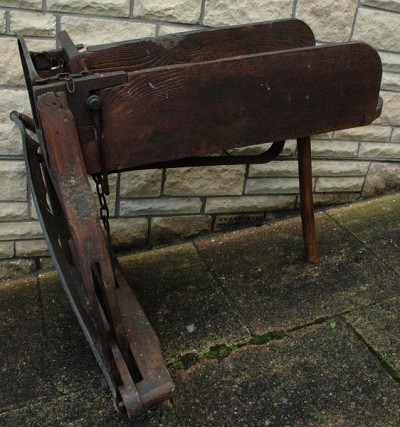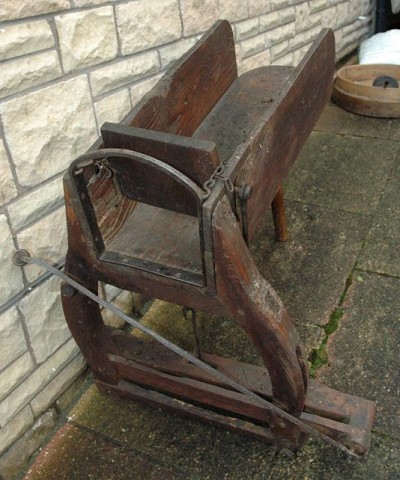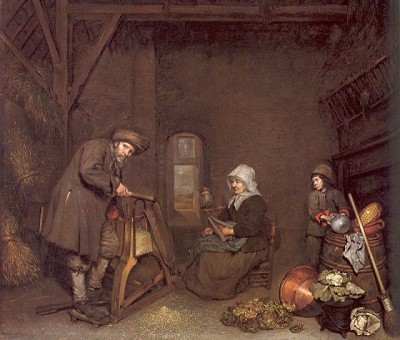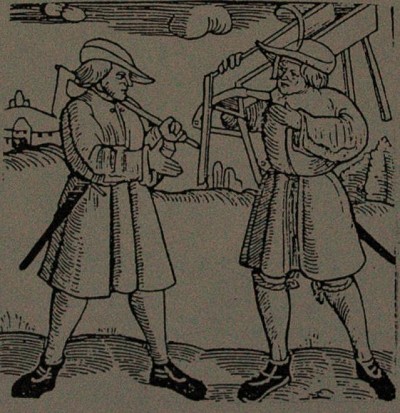THE “CHAFF BOX” OR “CHAFF CUTTER”
This page lists antique hand farm tools (used mainly in England, Wales and Scotland) collected by P. C. Dorrington between 1985 and 2001.
The chaff box or cutter was a simple but ingenious device for cutting straw chaff, hay, and oats into small pieces – before being mixed together with other forage and fed to horses and cattle. Apart from being more economical than previous methods of feeding, this aided the animal’s digestion and prevented animals from rejecting any part of their food. Since the chaff box was made largely of wood (usually ash) with only a small amount of ironwork, it cost relatively little to make and, as a result, few farms, town or country stables were without one by the end of the eighteenth century.
There were two sizes, one of heavy construction which normally resided in the darkened corners of barns or stables and another smaller model made of pine or similar wood which was portable.
The barn version typically comprised of an open-ended, three-sided wooden trough between 3 foot 6 inches and 4 feet (1067-1220 mm) in length, 9 to 12 inches (229-305 mm) wide and 9 to 12 inches deep, mounted on either three or four legs approximately 22 inches (560 mm) high – giving an overall height of about 34 inches (863 mm). The rear leg or legs were sometimes taller than the front to tilt the trough forward to facilitate cutting. Both front legs of an early three-legged form were distinctly bow-shaped, a characteristic of boxes from Kent and Sussex, while those with four legs were splayed.


Three-legged form in collection
To advance the bundle of hay or straw along the trough on all but the earliest models, a short-handled dwarf or chaff fork with between four and six tines was provided, attached by chains to the front of the box. These forks varied in width between 230-250 mm, depending on the inside dimensions of the trough. The tines were about 120 mm long.
The front end was framed by a metal plate which looped over the top to provide a useful lifting handle. Below this a large knife was hinged diagonally to a single or double sided arm which extended pivotally from the base of one front leg and passed through the hollowed centre of the opposite leg. This allowed the knife to be moved up and down in an oblique cutting action, rather like a modern office guillotine. The plate stiffened the straw at the cutting edge as the sharpened blade passed close by.
The early chaff knives had a scimitar like shape with a curved blade broadening towards a cranked wooden handle. Most ended their days with undulating edges. Scythe blades were often modified and used. From the 1860’s most factory produced replacement knives were made with straight cutting edges varying in length between 20 and 34 inches with cranked or crosshead handles. At least nine large edge tool manufacturers produced them in numbers including Isaac Nash & Sons – who continued to advertise their best ‘Crown’ chaff knives in the 1930’s. The cutting position on some could be adjusted by moving the pivotal or hinge bolts into alternative holes drilled along the appropriate end of the knife arm. When not in use the knife rested in an open-ended bracket or stop situated half way down the opposite front leg. Knives were removed for thorough sharpening. Left-handed boxes were uncommon.
Beneath the box, a treadle, hinged to the knife arm or the adjacent leg, operated a woodblock clamp situated inside the trough just behind the cutting edge. Its purpose was to compress the straw before cutting. The clamp was held by a narrow length of the iron bar which extended through vertical slits cut in both sides. In pre-1800 form, this bar had looped ends from which ropes drew the clamp down on to the straw. But, in order to move the straw forward after each cut, the clamp had to be continually pulled up by hand using a piece of cord tied between the side and an iron staple located on top of the clamp. In a later development, the clamp was perforated by a spindle and held between an inverted bracket joined to the treadle by a single hook or chain. By 1815 this type of linkage had been sprung by a length of spring steel or wood bolted under the feed end which automatically returned the clamp to its upper pre-compression position whenever the treadle was released. Some boxes, however, were equipped with a less widespread form of recoil springing, the principle of which probably originated in Europe. It comprised of two springy wooden poles fastened to the rear sides of the box, the overhanging ends of which were tied to the ends of the clamp bar. Another more durable method of springing was provided by a pair of side-mounted steel rods attached directly to the clamp spindle. These rods, under tension, were slightly curved and fastened by brackets towards the feed end of the box.
Caspar Netscher, “The Chaff Cutter, Woman and Child”, c1659, Philadelphia Museum of Art.

Working with a sprung clamp the trough was filled with straw and with the operator’s left hand holding the curved handle of the dwarf fork, the tines embedded in the bundle, the operator pushed it forward under the raised clamp to an inch or so past the cutting edge. Then with his left foot on the treadle, his right hand holding the knife, he pressed the treadle down compacting the straw, raised the knife to a high position and brought it down and across the face of the cutting edge slicing the protruding straw into half inch (13 mm) long pieces. The foot was taken off the treadle, releasing the straw and the fork used to push the bundle forward again to repeat the process. The operator sometimes stood with his right foot on a small stool to apply more downward pressure on the treadle with his left foot. For two man working, often a man and a boy, some boxes were equipped with a additional but smaller chaff fork with only three tines situated and secured at the feed end. The assistant loaded the straw and moved it along with this fork to the operator who continued as before. A stable riddle or baiting sieve was usually placed below the cutting end to catch the cut chaff.
It required considerable dexterity to master the feed, treadle and cutting actions. In the hands of a skilled person, however, it was said that between fifteen and twenty cuts could be made every minute and that a man could produce forty bushels of chaff per day. But the implement could be unforgiving in the hands of an inexperienced worker and there is little doubt that during its history its misuse caused some personal injury. This was especially true of the earliest models which, like the portable version, had no forks or clamps and were hand fed to the cutting edge. This is probably why farmhands in Kent nicknamed it the ‘Monkey Box’ or ‘Monkey Jumper’. In some places it was better known as a ‘Chaff Horse’ or ‘Cutter’. Originally, however, it was referred to as a ‘Cutting Box’ or a ‘Chaff Engine’ after the earlier custom of naming anything remotely mechanical an ‘Engine’.
In the early days some enterprising labourers and part-time thatchers learnt to use small portable chaff boxes which they carried on their backs visiting town and country stables offering a chaff cutting service for an agreed rate. The practice spread and it was not long before men were being paid comparatively good wages, inviting Arthur Young in 1804 to comment that they “usually made much greater earnings than the common pay per diem”. In mid-18th century Hertfordshire the fee was said to be “one penny per double bushel” but later reports put the amount at one penny per bushel cut. For an “extraordinarily fine cut”, Midland men received only three farthings for a heaped bushel (William Marshall 1790). Being portable, the boxes were lightly constructed, about half the normal size and for the most part were equipped only with a swivel knife of appropriate length. Consequently, they lacked the safety features and other refinements found on later barn models. Some time afterwards an improved version was introduced. As the demand for cut chaff increased, farmers found it more beneficial to acquire the larger capacity boxes themselves and with slightly increased incentives (and presumably some training), prevailed upon their ploughmen or stable lads to use them instead. The days of the travelling ‘Chaff Cutters’ as they were once known became numbered and according to a census of 1851 not more than 335 remained in employment. Excepting a few areas, the business came to an end in England in the early 1900’s.
Most of the chaff box’s features had been established around the turn of the eighteenth century. By then, however, it was beginning to compete with the new but relatively untried rotary chaff cutter which had first appeared in small numbers in the 1770’s.
Perhaps noting the early development of these rotary machines, attempts were made to improve the box still further. One apparently successful model used in the Midlands incorporated a semi-automatic feed arrangement where a sliding fork pulled by ropes wound around a small windlass pushed the straw forward in the trough every time the treadle was released for the next cut. The windlass, located over the front end, was fitted with a ratchet wheel and levers which controlled the forward movements. When the trough required refilling the ratchet was disengaged, the fork slid backwards along a ledge to be removed at the end of the box and then replaced on to new straw. As both hands were freed for cutting a double-sided knife handle was provided. Probably referring to this box in 1790 William Marshall thought it was “somewhat complex and fitter for a man who makes business of straw cutting than for a farmer’s servant”. Another innovation from Norfolk employed a fluted feed roller through which straw was compressed before cutting. There were also other less well-disseminated variations.
Despite, these developments, which peaked around the 1830’s, the chaff boxes became increasingly displaced by the faster and then more efficient rotary cutters with their automated feed systems. Even so, they remained in use, especially on smaller farms and stables in England and Wales until the 1930’s, becoming, in some instances, a stand-by for mechanical failures. The Welsh found them convenient for chopping up gorse for fodder and several were brought out of retirement during World War II. A few were also retained by thatchers for cutting reeds to size. Their longevity was probably due to their cheap and simplistic construction, readily undertaken by any competent craftsman especially when viewed against the expense of the new machines costing at least four to five times as much. Distribution was principally confined to the Southern Counties, parts of the Midlands and Wales. Apart from stagecoach stations there is little evidence of chaff box use in Northern England or in Scotland before the widespread adoption of the rotary chaff cutter.
The business of chaff cutting began on the Continent long before it occurred in England. As far back as the late 15th or early 16th century, chaff cutters were plying their trade in central Europe where the box may have originated. A model shown in the Augsburg drawing of 1524 gradually evolved as its use spread through Germany, and, in particular, Holland and Belgium from where an early example is thought to have been introduced into England during the 17th century, quite possibly by Flemish immigrants to Kent.
Earliest known depiction of a chaff-cutter: woodcut from Augsburg, 1524

Despite being aware for 200 years of the European method of feeding horses with finely chopped straw “cut fit by an instrument of purpose” (Blundeville 1565) no public interest was shown in the subject until the mid-18th century. An early indication of its presence here came with John Lewis’s book, “The History and Antiquities, Ecclesiastical and Civil, of the Isle of Tenet in Kent” of 1723. He described how “oats, beans and peas in the sheaths unthreshed” were “cut in a box with a cutter made for that purpose which was pretty hard work”. In a second edition published 13 years later he included a drawing of a three-legged “Cutting Box to cut horse meat in” – meat in this case meaning fodder. The free-standing model shown comprised of nothing more than a swivelling knife attached to a wooden trough on legs, but like the Augsburg example its significance lay in its unique cutting action. In 1745 William Ellis’s book “Agriculture Improved” appeared. The author, given to some salesmanship, referred to a ‘famous’ and ‘profitable engine’ which he claimed “may be so worked as to cut sixty single or thirty double bushels of chaff in one day by one man”. He also states the engine “serves to employ servants in rainy days within doors when they cannot work without”. Indeed, according to Ellis, the engine was “kept by most great farmers in Southern England” and he offered to supply the implement to readers at a cost of one guinea plus carriage charges. Unfortunately, Ellis did not provide a drawing, but before his death in 1758 he wrote of the chaff cutter’s way of placing a large handful of oat straw and cavings of wheat “at the bottom of a long cutting box which being pulled all together forward to the knife, by a forked instrument”, the latter an early reference to the use of a dwarf fork which later became widespread.
A letter from an anonymous correspondent in Canterbury published in the journal “Museum Rusticum et Commerciale” of 1764 recommended the use of a ‘cutting box’ for preparing feed and accompanied it with a drawing and description which though a right-handed version was virtually identical to Lewis’s illustration 28 years earlier. Two respondents, Thomas Comber and James Crockett, suggested improvements but most were either impractical or unworkable. By this time, however, the Continentals had already introduced a number of modifications some pre-dating the early English boxes by 100 years or more. Almost certainly some of these developments crossed the English Channel during this period and were used or adapted to suit local requirements.
The chaff box was the forerunner of all straw cutting machines and undoubtedly one of the most creative inventions in pre-mechanical agriculture. Although comparatively short-lived in Britain, the basic design had lasted for over four hundred years in Europe. Being mainly of wood only a small number have survived the ravages of time intact. Some examples, however, may still be seen at various rural life museums including Avebury, Cobtree, Colchester, Gressenhall, Oakham and Reading (see links page). Most of these would have been constructed during the nineteenth century.
P.C. Dorrington, 2004
GED postscript: in 2005, steel-frame chaff cutters were still being manufactured in India and advertised on the worldwide web.
TOP pages – prestigequeen.com:
- Best Chicken Egg Incubator
- The BEST chicken WATERERs
- Rat Proof Feeder for chickens
- Best Chicken Heaters
- The BEST cheap CHICKEN COOP
- The best AUTOMATIC chicken coop DOOR
- The best NESTing BOXes for chickens
- The Best Animal Repellents for Backyard
- The Best Plucker Machine
- The Best Toys for Chickens
- The best BOOKS on raising CHICKENS
- What’s the Best CHICKEN FEED?
- How to Keep Fox Away from Chickens?
- Candler Egg Tester
